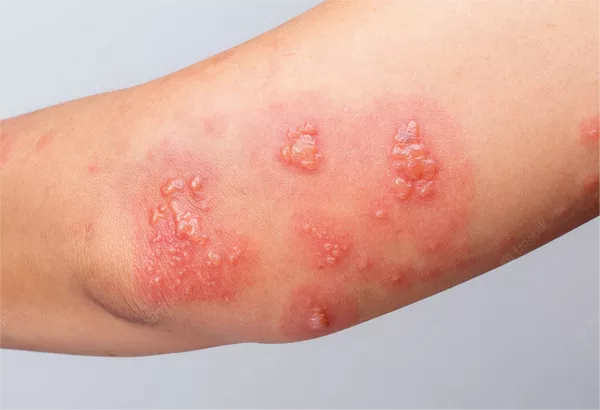Skin fungus, also known as dermatophytes, can affect anyone, regardless of age, gender, or overall health. It’s a common condition that can appear in various forms, such as athlete’s foot, ringworm, jock itch, or yeast infections. Fungal infections on the skin may cause discomfort and lead to unsightly rashes, itching, or even pain. Understanding why fungus grows on your skin is crucial in treating it effectively. In this article, we will explore the reasons behind skin fungus and what you can do to prevent and treat it.
What is Skin Fungus?
Skin fungus refers to infections caused by microscopic fungi that thrive on the outer layer of your skin. These fungi feed on keratin, a protein found in the skin, nails, and hair. Fungal infections are often contagious, and they can spread from person to person or through contaminated objects like towels, clothing, or bedding.
There are two main types of fungi that affect the skin: dermatophytes and yeasts. Dermatophytes are responsible for most skin fungal infections, while yeasts, such as Candida, can lead to fungal infections in moist areas of the skin.
Common Types of Skin Fungal Infections
Skin fungal infections are common and can affect various parts of the body. Some of the most common types include:
Athlete’s Foot
Athlete’s foot is a common fungal infection that typically affects the feet, particularly the areas between the toes. It can cause itching, redness, and peeling of the skin, and in severe cases, it may cause blisters or cracks. Athlete’s foot is often caused by dermatophytes that thrive in warm, moist environments like shoes and locker rooms.
Ringworm
Despite its name, ringworm is not caused by a worm but by a fungal infection. It often appears as a red, circular rash with a raised border. It can appear on any part of the body, including the scalp, face, or groin. Ringworm is highly contagious and can spread through direct contact with infected individuals or contaminated objects.
Jock Itch
Jock itch, also known as tinea cruris, is a fungal infection that typically affects the groin area. It causes itching, redness, and a rash that may spread to the inner thighs, buttocks, or genital area. This infection is common among athletes and individuals who sweat a lot, as the fungi thrive in warm and moist environments.
Yeast Infections
Yeast infections on the skin, typically caused by the Candida species, can occur in areas of the body where moisture accumulates, such as the armpits, groin, or under the breasts. The infection may cause redness, itching, and a white, cottage cheese-like discharge in more severe cases.
Why Do Fungal Infections Occur?
Fungal infections on the skin occur when the balance between the skin’s natural defenses and the fungi in the environment is disrupted. Several factors can contribute to the development of fungal infections. Let’s look at some of the most common causes:
1. Warm, Moist Environments
Fungi thrive in warm and moist conditions. If you sweat excessively or spend time in environments where sweat cannot evaporate easily, such as wearing tight shoes or clothing, the fungi may multiply, leading to an infection. Areas like the feet, groin, and armpits are especially prone to fungal growth because they provide the ideal conditions for fungi to grow.
2. Poor Hygiene
Maintaining proper hygiene is essential in preventing fungal infections. Failing to wash and dry your skin regularly can lead to the buildup of sweat, oils, and dead skin cells, providing a fertile environment for fungi. Wearing dirty clothes, socks, or towels can also increase the risk of fungal infections.
3. Weakened Immune System
A weakened immune system makes it harder for the body to fight off infections, including fungal ones. Conditions like diabetes, HIV/AIDS, or the use of medications that suppress the immune system (such as steroids or chemotherapy) can increase your susceptibility to skin fungal infections. In people with weakened immune systems, fungal infections can be more severe and harder to treat.
4. Overuse of Antibiotics
Antibiotics are effective at killing bacteria, but they can also disrupt the natural balance of microorganisms on the skin. This imbalance can allow fungi to grow unchecked, leading to infections like yeast infections. If you’ve been taking antibiotics for an extended period, it may increase your risk of developing a fungal infection.
5. Skin Trauma
Injuries to the skin, such as cuts, abrasions, or insect bites, can provide an entry point for fungi. When the skin’s protective barrier is compromised, it becomes easier for fungi to invade the tissue and cause an infection. Fungal infections are more likely to occur in areas where the skin is broken or irritated.
6. Excessive Sweating
People who sweat excessively, also known as hyperhidrosis, are at higher risk of developing fungal infections. The moisture and warmth created by sweat provide an ideal breeding ground for fungi, especially in areas like the feet, groin, and underarms. Wearing non-breathable clothing or shoes that trap sweat can make the situation worse.
7. Tight-Fitting Clothing
Wearing tight clothing, especially in areas prone to sweating like the groin or underarms, can increase the risk of fungal infections. Tight clothing prevents air circulation and can trap moisture against the skin, creating an environment that promotes fungal growth.
8. Sharing Personal Items
Fungi are highly contagious and can spread from person to person through direct contact or by sharing personal items such as towels, clothing, shoes, or bedding. If someone close to you has a fungal infection, it is important to avoid sharing personal items and to keep the infected area covered to prevent spreading the infection.
Symptoms of Fungal Infections
Fungal infections on the skin can present in various ways, depending on the type of fungus and the area affected. Some common symptoms include:
Itching: Fungal infections often cause intense itching, especially in areas where moisture accumulates, like the feet or groin.
Redness: The affected area may appear red, inflamed, or irritated. This is a sign that the skin is reacting to the infection.
Rashes: A rash, often circular or ring-like, is a common symptom of skin fungal infections like ringworm.
Peeling or Cracking: Infections may cause the skin to peel, crack, or blister, especially in areas with excessive moisture, like between the toes.
Burning Sensation: Some fungal infections cause a burning feeling in the affected area, which can be uncomfortable.
Scaly or Flaky Skin: In more severe cases, fungal infections may cause the skin to become dry, scaly, or flaky.
How to Prevent Fungal Infections
While fungal infections are common, there are several steps you can take to prevent them:
Keep your skin clean and dry: Wash your skin regularly with soap and water, and dry it thoroughly, especially in areas where moisture accumulates.
Wear breathable clothing: Choose loose-fitting, moisture-wicking clothing made from natural fabrics like cotton. This helps keep sweat from building up on your skin.
Change clothes regularly: After exercise or sweating, change into clean, dry clothes to prevent fungal growth.
Avoid tight shoes: Wear shoes that allow your feet to breathe, and change socks frequently to prevent moisture buildup.
Don’t share personal items: Avoid sharing towels, shoes, or clothing with others, especially if they have a fungal infection.
Use antifungal powders: If you are prone to fungal infections, consider using antifungal powders or sprays to keep areas like your feet and groin dry.
Treatment for Fungal Infections
Fungal infections are typically treatable with antifungal medications. Over-the-counter antifungal creams, powders, or sprays can be effective for mild infections. These products are designed to kill the fungi and reduce symptoms like itching and redness. For more severe infections, a doctor may prescribe oral antifungal medications or stronger topical treatments.
If you suspect a fungal infection, it’s important to seek medical advice. A healthcare professional can accurately diagnose the infection and recommend the appropriate treatment.
When to See a Doctor
Most skin fungal infections can be treated at home, but you should see a doctor if:
- The infection doesn’t improve after using over-the-counter treatments.
- The infection spreads rapidly or affects a large area.
- You have a weakened immune system or other underlying health conditions.
- The infection causes significant pain or discomfort.
Conclusion
Fungal infections on the skin are common, but they are preventable and treatable. By maintaining proper hygiene, wearing breathable clothing, and avoiding excessive moisture buildup, you can reduce your risk of developing a fungal infection. If you do develop a fungal infection, treatment options are available to help clear the infection and prevent it from coming back. Understanding why fungi grow on your skin and how to prevent them is essential in maintaining healthy, infection-free skin.
Related topics


























